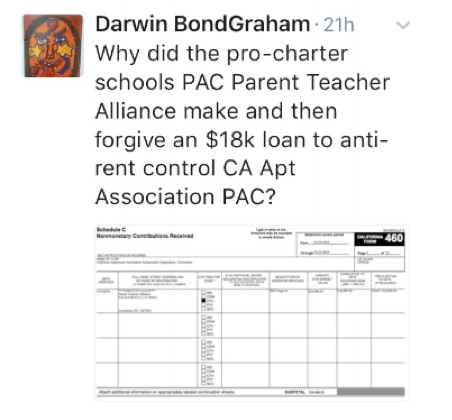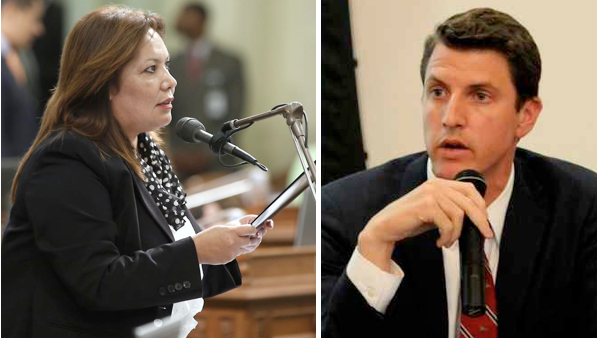Is California Still Hangin’ Out at the Home of the Free and the Brave?
ALPERN AT LARGE--Freedom isn't for sissies. Life is complicated, but that doesn't mean we shouldn't confront it--particularly in a free society, where our decisions aren't supposed to be made for us. If America is "the home of the Free and the Brave", then the obligations of freedom are NOT above and beyond us.
Our California ballot is so very complicated, and with so many taxation and policy questions, it's easy to run away screaming from your ballot box and/or absentee ballot envelope. But with the understanding that you need not vote for every measure and/or proposition or election race, here are a few considerations:
1) Taxing a few of us for something we're all supposed to benefit from is neither democratic, courageous, nor moral. If it's good enough to tax some of us, then tax all of us.
The argument that the more wealthy should pay more than those less wealthy makes sense, but how to do it in a fair manner will be argued long after we're gone. If we don't all have some skin in the game, and if the money's not supervised with respect to transparency and quality spending, then why do we need to nail other financially and hurt our economy?
Joel Fox, former president of the Howard Jarvis Taxpayers Association, states it well when he decries how California--home of Proposition 13--appears willing to tax itself into oblivion, particularly when it's "someone else" who'll pay the taxes for YOUR pet priorities.
Of course, many of those who tried to keep California on an even keel have retired and left the state, or have passed away, leaving poorly-educated new generations who think that the warnings of Big Government are all crazy and for paranoid seniors (I guess the worshiping of youth has replaced the respect of elders and the knowledge/wisdom they've collected over their lives).
And for those of you willing to vote for OTHERS to pay more for what YOU want...well...how brave of you. How BRAVE of you!!!
2) VOTE NO on Proposition 55: Ooooooh, those awful rich people! Get 'em! Make 'em pay their fair share! So I guess that the "big lie" that this tax on those making $263,000 per year would be temporarily taxed is being shown as just that...a lie. And does that figure carry the same weight and wealth as it does in states with a lower cost of living?
And if more small business owners, who work 80-100 hours a week for that money, leave the state (along with your job), that'll make you happy? And is paying over 50% of your income in federal and state income taxes enough to make lower-income Californians satisfied? And will the money, supposed to go to education, BE ... SPENT ... WELL?
Is our tax dollars, particularly our education tax dollars, being spent well in California? Do you really favor the public sector education unions over your own job/employer?
3) VOTE NO on Proposition 56: Oooooooh, those awful cigarette smokers! Get 'em! Make 'em pay their fair share! Because there are so MANY smokers left and because that extra money will be spent so ... damn ... well! Best that we enact laws that require higher healthcare premiums and life insurance premiums for smokers (the latter already exists).
4) VOTE YES on Propositions 53 and 54: Transparency is good. Bonds have to be paid back, and if it's over $2 billion then the taxpayers should vote on it. Ditto with us all being able to see legislation online for at least 72 hours before Sacramento can vote on it.
... and in other races where we have to S.O.S. (Save Our State) ...
5) VOTE NO on Proposition 57: What...the jump in crime after we passed Proposition 47 wasn't enough for you? You think that there are just gobs and gobs of innocent sweeties those nefarious prosecutors and judges threw away in jail for funzies, and that their ridiculously-long rap sheet means nothing? You really want to put yourself and your family at risk...AGAIN?
6) VOTE NO on Proposition 58: Latino children have been among the chief beneficiaries by requiring families to specifically request for bilingual/immersion education programs. Passing this would be a step backwards--if someone is bilingual, then that is an unqualified plus in our world. But if a child doesn't speak and learn English first, then it's a guaranteed restriction on their future.
7) VOTE NO on Proposition 64: We already look the other way for those with small amounts of recreational marijuana, and already are OK with medicinal marijuana. You want more DUI's for those high on pot (which is by far more available in high concentrations today than in the past, and are virtually hallucinogenic at certain doses) like in other states? There's a difference between tolerating pot, versus telling your kids it's "just fine" or to even watch advertisements go up that virtually encourage teenagers and kids to "go for it" when it's legal (or even earlier). VOTE NO!
8) VOTE NO on Proposition 62, and YES on Proposition 66--Mend it, don't end it! The death penalty exists for a reason, and reasonable reforms and commutations have already been made (and should continue to be made) for the protection of the innocent. Do NOT reward those who ultimately seek to let those truly guilty of monstrous crimes out of prison, and/or who do NOT truly understand the unforgiveable act of first-degree murder. Please speak for the rights of the slain--because they cannot speak for themselves! Victims' lives matter ... right?
9) Vote YES on Measure M--I am no hypocrite, and no purist. I've already opined that we shouldn't need Measure M, but we damn well do!!!
With respect to transportation, the public education lobbies have financially crippled the state with respect to proper budgeting. LA County MUST Save Itself! And demand matching grants from Sacramento and Washington whenever possible!
Measure M taxes all of us, and is filled with BOTH freeway and rail projects, as well as operational and sidewalk/road repairs that we all can benefit from. Chambers of commerce, newspapers throughout the County of LA and among those benefiting the most from transit projects.
Former County Supervisor Yaroslavsky, who helped kill the subway construction bonanza when the spending was out of control in the 1990's, favors Measure M, and he earned his reputation as a fiscal conservative.
And I am also a fiscal conservative, recommending a "no" vote on every tax/bond initiative in the city, county, and state...but Measure M is the big exception, and we can fight for more transportation, and better inclusion for the county, the very day after we pass it.
But we MUST pass Measure M.
Again, freedom isn't for sissies. We should NOT, even in the la-la land of California, forget that we are part of the Home of the Free and the Brave. No taxes or stupid Big Government when it's unhelpful.
But when we tax ourselves, or make policies that affect all of us, let's all do it together--including that taxpayer/voter you see in the mirror every day.
(Ken Alpern is a Westside Village Zone Director and Board member of the Mar Vista Community Council (MVCC), previously co-chaired its Planning and Outreach Committees, and currently is Co-Chair of its MVCC Transportation/Infrastructure Committee. He is co-chair of the CD11Transportation Advisory Committee and chairs the nonprofit Transit Coalition, and can be reached at [email protected]. He also co-chairs the grassroots Friends of the Green Line at www.fogl.us. The views expressed in this article are solely those of Mr. Alpern.)
-cw



 In my opinion it is because she is at every event in her district. She knows her communities and fights for them. One recent success was her spear heading efforts, along with other organizations in the community. to open a satellite branch of Mission Hills College in Sunland. They broke ground last month.
In my opinion it is because she is at every event in her district. She knows her communities and fights for them. One recent success was her spear heading efforts, along with other organizations in the community. to open a satellite branch of Mission Hills College in Sunland. They broke ground last month. 
 Atake’s point shines a glaring light on the comprehensive lack of prior humane experience by virtually all of Garcetti’s current shelter Commissioners:
Atake’s point shines a glaring light on the comprehensive lack of prior humane experience by virtually all of Garcetti’s current shelter Commissioners: 








 One consequence of this convoluted planning process is that the city’s public infrastructure and services -- like the football stadium in our analogy -- are ignored. The Department of City Planning defines their day-to-day planning mission as the efficient processing of developers’ requests for discretionary actions. It is not comprehensive, rigorously monitored planning, but what the executive suite calls the “development process,” and what they publicly define as promoting foreign and domestic
One consequence of this convoluted planning process is that the city’s public infrastructure and services -- like the football stadium in our analogy -- are ignored. The Department of City Planning defines their day-to-day planning mission as the efficient processing of developers’ requests for discretionary actions. It is not comprehensive, rigorously monitored planning, but what the executive suite calls the “development process,” and what they publicly define as promoting foreign and domestic 





 Bill Zimmerman, a longtime California political campaign manager, says the current wave of law enforcement support for the death penalty is a reaction to increased scrutiny over police and prison officials. The unions, he says, are “feeling threatened by this climate of police reform. They see this as a battle in a long war, and it’s a battle they don’t want to lose. If they can win this battle, they see it as something that gives them more clout, or at least the perception that they’re a powerful political force when it comes to legislative matters.”
Bill Zimmerman, a longtime California political campaign manager, says the current wave of law enforcement support for the death penalty is a reaction to increased scrutiny over police and prison officials. The unions, he says, are “feeling threatened by this climate of police reform. They see this as a battle in a long war, and it’s a battle they don’t want to lose. If they can win this battle, they see it as something that gives them more clout, or at least the perception that they’re a powerful political force when it comes to legislative matters.”
 “‘Reasonably foreseeable,’ we’ve been wondering what that meant, and I guess the answer is that it depends on the species and the circumstance,” Parenteau said. “Pushing it out 50 to 100 years is certainly pushing the envelope on ‘foreseeable.’ I can see where other courts would disagree with that and think it is speculative.”
“‘Reasonably foreseeable,’ we’ve been wondering what that meant, and I guess the answer is that it depends on the species and the circumstance,” Parenteau said. “Pushing it out 50 to 100 years is certainly pushing the envelope on ‘foreseeable.’ I can see where other courts would disagree with that and think it is speculative.”

 These oversized second units can be squeezed into backyards in single family neighborhoods throughout Los Angeles -- and sometimes into front yards! And, even though the City’s adopted standards would otherwise forbid it, the 140 second unit applications filed during the 5-day end of September “window” can be built in designated “hillside” areas and on “substandard” streets. (Ugly, severely impacting second units of the kind allowed under the default standards during the 5-day window can be seen in the attached photos.)
These oversized second units can be squeezed into backyards in single family neighborhoods throughout Los Angeles -- and sometimes into front yards! And, even though the City’s adopted standards would otherwise forbid it, the 140 second unit applications filed during the 5-day end of September “window” can be built in designated “hillside” areas and on “substandard” streets. (Ugly, severely impacting second units of the kind allowed under the default standards during the 5-day window can be seen in the attached photos.) 
















